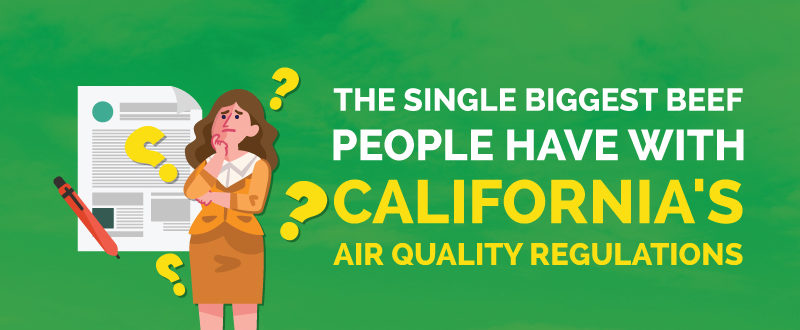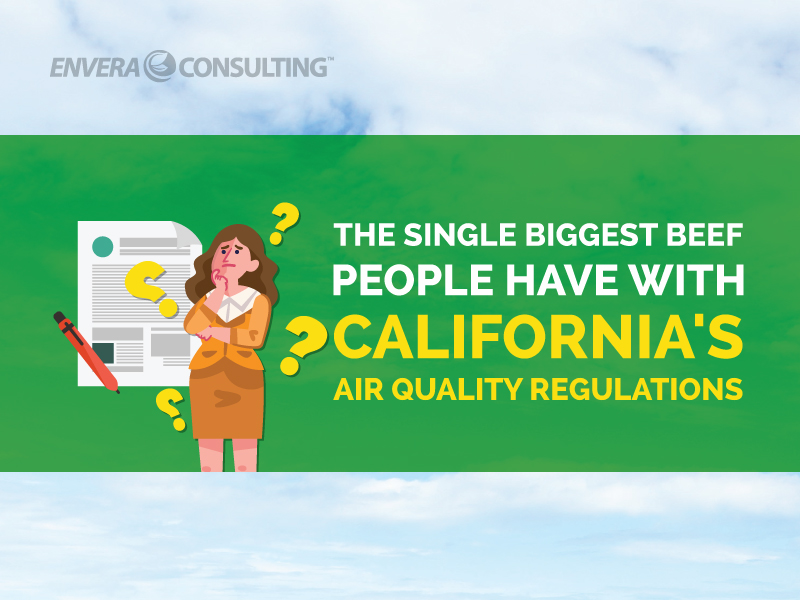

I’d be willing to bet that this is how most people feel when they work with California’s air quality regulations:
For the past few years, I’ve been cataloging the beefs that people have when working with the regulations.
Here are just three of many comments that I’ve collected:
There are no clear guidelines available to find information about [SCAQMD] compliance. If you don’t have the experience, know where to look, or how to look for it, oftentimes the information seems impossible to find. There is really no substitute for experience here, but for a lot of smaller businesses and industries with compliance needs that are not overly complex, I think there should be more tools available to make this easier for them.
For lack of a better descriptor, the most problematic obstacle encountered when a professional is first embarking on the air quality arena is directing their compass. Where do you start? On a regional, state, or federal level? Once you’ve set your direction, weeding through the regulations, evaluating applicability, creating your index of pertinent rules, and developing your compliance plan is the real challenge.
Biggest problem is not knowing where to start. [SCAQMD] compliance is like a web, and at first I didn’t know which local regs were similar to which federal regs — things like that.
While this is just a small sample of the responses we’ve collected. When going through them all, I’ve noticed some recurring themes:
- Folks don’t know where to start and how to connect the dots.
- Folks want to see how things fit into the big picture.
- Folks want direction when it comes to air quality regulations since the information is scattered across numerous sources.
Which all boils down to one big beef: The rules are just too darned complex.
And there’s a reason for all that.
The regulations are a complex web of legalese, tables, and paper that, taken as a whole, read like a radio manual. In a foreign language.
Let’s start by talking about some of the reasons why the regulations are so complex.
In California, There Is No Single Agency Responsible for All Air Quality Regulations
One of the reasons why the regulations are so complex is that responsibility for the regulations is scattered among federal, state, and local agencies. As a whole, California air quality regulations are an amalgam of all sorts of initiatives and possible solutions to the air quality problems that a given area is faced with. That’s because sources of air pollution are highly varied and voluminous in number.
To make things more complicated, the regulations can change within geographical areas. California has 34 air districts, each with its own rules and regulations that were designed to solve — or at least mitigate — each area’s unique air quality problems. In short, areas with dirty air tend to have a higher number and more stringent regulations than areas with cleaner air.
Three Agencies That Each Have Their Own Air Quality Regulations
In California, air quality regulations can come from three agencies, all with differing level of authority. Some of the general responsibilities of each agency are listed below.
EPA (Environmental Protection Agency). Establishes the national ambient air quality standards and oversees air quality programs for individual states; regulates mobile sources.
CARB (California Air Resource Board). Establishes state ambient air quality standards; regulates sources of toxic air emissions; implements California’s greenhouse gas reduction program, also known as Assembly Bill 32, the Global Warming Solutions Act.
SCAQMD (South Coast Air Quality Management District). Establishes rules and regulations for stationary sources of air pollution; implements state and federal regulations through auditing/inspections and permitting.
Different Types of Air Quality Regulations
In general, a given facility can be subject to one or more of the regulations in the following areas:
Command and control. The quintessential type of air-quality regulation is one known as command and control (CAC). Under a CAC regulation, the agency’s rules state the amount of emissions allowed from a specific source. If the agency wants to reduce the amount of a specific pollutant, it can do so by simply amending the specific rule. Facilities that are subject to these rules must make any necessary changes to meet these requirements, which can include implementing process changes or installing control equipment.
Each of these source-specific rules has its own set of compliance requirements, which typically consist of collecting data, keeping records, and preparing and submitting reports.
Market-based regulations. These types of regulation involve setting a price and a cap on a facility’s emissions. With this price and cap, facilities are able to freely emit to the amount of their cap; however, if they want to emit in excess, they must pay in order to do so. Examples of these types of programs include the RECLAIM program, the aforementioned AB 32, the Acid Rain Permit Program (Regulation XXXI), and the EU ETS (European Union Emissions Trading System).
Disclosure regulations. Disclosure regulations require that a covered facility tell the public about the types and amounts of emissions coming from their facility. In some cases, these regulations also require that the facility implement a reduction plan if the emissions exceed certain levels. Examples of these types of programs include EPCRA (Emergency Planning and Community Right-to-Know), Air Toxics “Hot Spots” program (AB 2588), Prop 65 (officially known as the Safe Drinking Water and Toxic Enforcement Act of 1986), etc.
When it comes to California’s air-quality regulations, the difficulty stems from the fact that a single facility may need to comply with regulations from the EPA, CARB, and SCAQMD.
And since each agency and regulation can have its own requirements and reporting deadlines, this can be a task on it itself. For example, a single facility may be required to submit annual emission reports to the SCAQMD by March 1, a greenhouse gas report to the EPA and the CARB by April 10, a TRI (Toxic Releases Inventory) by July 1, and ongoing monthly reports to the RECLAIM program. In addition, a facility needs to keep track of changing regulations as well as improvements that may be planned for the facility itself (which may require the identification of its own regulations).
I’m So Confused. Where Do I Start?
Here’s the reality of it: Knowing what agencies regulate what pieces of equipment takes some experience and exposure to this level of organized chaos.
However, there are some basic guidelines that you can use to navigate through the web of regulations. Start by moving down this list sequentially. In some cases, you will be pointed to the rules of other agencies within the rule itself (however, this is not always the case).
- For stationary sources such as engines, boilers, and manufacturing processes, start with the rules of the local air district (in the greater Los Angeles area, that’s the SCAQMD), but don’t assume that the SCAQMD’s regulations are the only regulations that you need to comply with. There very well may be others. (In fact, I’d bet on it.)
- For stationary sources that emit greenhouse gases and air toxics, start with the rules of CARB. Here’s a tip to save you some headache when doing so: The CARB’s regulations are found in the California Code of Regulations (CCR), which is not as organized as the SCAQMD’s rulebook and is quite a bear to wade through. If you need to find information about a specific CARB regulation, I recommend first doing a search on their website to find some basic information. Once you have a general feel for the regulation, go to the CCR to read the regulation itself.
- Larger emission sources (power plants, refineries, etc.), as well as those that primarily emit air toxics and greenhouse gases, are subject to the EPA’s rules. You’ll want to take the same approach when tackling the EPA’s regulations as you did with the CARB’s, for the same reason. The EPA’s regulations are buried in the Code of Federal Regulations (CFR), which has grown in page number by more than 150 percent, from 71,224 pages in 1975 to 178,277 in 2015 (as determined by The George Washington University). So do yourself a favor and start with a general topic search and drill down from there into the actual regulation.
As a side note, the Texas Commission of Environmental Quality has a really helpful table of all of the NESHAP (National Emission Standards for Hazardous Air Pollutants) and NSPS (New Source Performance Standards) regulations.
Unfortunately, the downside to first doing a general topic search is that you need to know what you’re looking for from the start. It’s a skill that needs to be developed over time.
One tip that has worked in the past is to use the SCAQMD’s Form 500 C1 as a guide to find some of the EPA requirements that a specific process or operation may be subject to. First, find your process in the left-hand column named “Equipment/Process,” then find all the federal requirements in the “Applicable Requirement” column that start with “40 CFR.” Obviously, this is not a complete list and does not include any California requirements, but it can help if you have no idea.
It’s quite common for a specific situation to not fit neatly into one of these areas but rather span several. In this situation, gather as much information as you can and get some help from a knowledgeable colleague, the agency itself, or even a consulting firm. However, so that your team isn’t chasing its collective tail, make sure to have the information listed below. One tip to remember with these rules is that content is everything, as gray areas are abundant.
Knowing what to do, particularly when you hit a gray area, requires a review of current rules and projecting what you think will happen, based on experience. As a practicing professional, I’ve learned that it becomes increasingly important to be able to synthesize the information you currently have into knowledge on areas that are not addressed. Even though there are tons of pages of regulations, they do not address 100 percent of the situations that exist. In fact, I’d hazard a guess that they address only a fraction. It’s up to you to take what is known and synthesize the information needed to extrapolate the unknown. (This is where things can get interesting, since there can be different interpretations as to what a certain regulation requires.)
So what types of information should you know when further researching a gray area?
- The type of equipment (engine, boiler, etc.)
- The type of fuel that is used (natural gas, diesel, etc.)
- The age of the equipment (< 1 year old, > 20 years old, etc.)
- The size of the equipment (50 MMBtu/hr, 100 BHP, etc.)
- The operational schedule of the equipment (24/7, etc.)
- The location of the equipment (state, city, etc.)
- The background of the facility or operation that the equipment is located at (type of operation, when were permits last applied for, etc.)
When it comes to California’s air quality regulations, knowing where to start can be a huge pain the butt, but at least you now have some guidance on how to do so. You can get more guidance on how to slog through California’s air quality regulations by joining our newsletter.